|
Crossens station was on the West Lancashire Railway (WLR) Company’s Southport & Preston Railway which opened in stages between 19 February 1878 and 6 September 1882. The WLR was promoted by Sir Thomas George Fermor-Hesketh, Bart. Royal Assent was given for the ‘West Lancashire Railway’ on 14 August 1871. The Act authorised construction capital amounting to £150,000. James Brunlees and Charles Douglas Fox were appointed as civil engineers, and the contract for construction was let to Clarke Pruchard and Co. The first sod was cut at a special ceremony held at Little London, in Southport, attended by the Mayor, Alderman Squire JP, on 18 April 1873. From the start the WLR project struggled financially and, although construction started successfully, it stopped abruptly when the contractor faced financial difficulties. A further WLR Act of 1875 authorised the raising of a further £187,500 and granted an extension of time for the line’s completion. A new contractor, Barnes & Squire, was appointed, and work resumed.
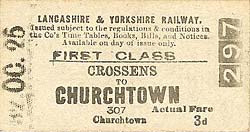 |
Crossens station was built by Bridges of Burscough Junction and opened to public services on 20 February 1878 when the WLR opened the first section of the line from Hesketh Park, in Southport, to Hesketh Bank. It was located on the north side of a bridge which carried Bankfield Road over the line. As the line was double-track two platforms were provided. The main station |
facilities were in a single-storey brick building on what would become the down (Preston-bound) platform, west side of the line. The building was L-shaped, with a canted bay looking out onto the platform beneath a gable-end and there were round-headed door and window openings. Adjoining this building was an open-fronted waiting area, with a small verandah carried on wooden posts and curved braces. A simple brick-built waiting shelter was located on the up platform.
There was a goods yard and shed on the up side of the line. On the down side there was initially a single siding. A signal box was north-west of the station on the down side.
At the time of opening Crossens was served by trains between Hesketh Park and Hesketh Bank, but on10 June 1878 the line was extended southwards to Southport Windsor Road.
On 19 August 1881 a tender was prepared for the erection of a carriage shed at Crossens, and it was built by 8 July 1882. It was east of the station on the up side of the line. Land at Southport had been too expensive, so the |
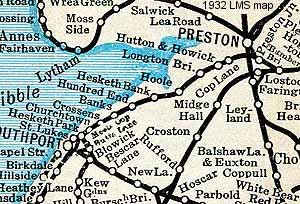 |
company chose Crossens as a suitable location.
The WLR completed the route to Preston on 6 September 1882, and from this date trains started to run from Crossens to Preston. To coincide with the completion of the route the WLR opened the new Southport Central terminus at the southern end of the line.
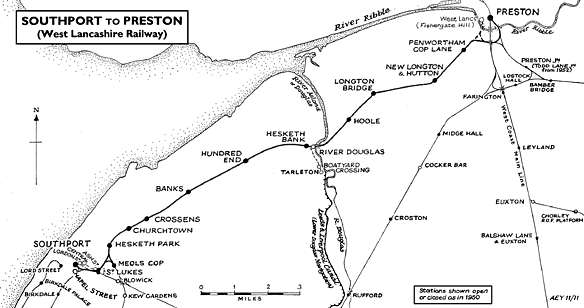 |
A WLR Board minute of 16 August 1893 recorded that the carriage shed was to be extended to accommodate twelve additional new coaches. This extension made the carriage shed 260yd long - a large installation in what was at that time a rural location. In September 1896 an additional down siding was provided at Crossens to serve the Churchtown Industrial Cooperative Society. It came into use after 1 October 1896.
On 1 July 1897 the Lancashire & Yorkshire Railway (LYR) took over the WLR. From 16 July 1900 they closed the WLR Preston station and diverted trains into Preston’s main line station. Southport Central closed on 1 May 1901, and all WLR line trains were diverted into Southport Chapel Street. The Churchtown Industrial Cooperative Society relinquished the use of their facility and it became an LYR general purpose siding from 24 May 1901. At about the same time the original goods shed was demolished.
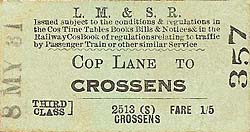 |
By this time Crossens had grown into an outlying residential district of Southport which resulted in the station becoming a busy commuter facility. The LYR decided to extend the electrification that it had planned between Liverpool Exchange and Southport Chapel Street onward to Crossens. The extension was prompted because Southport Corporation had |
introduced electric street trams to the northern suburb of Churchtown (the next station south of Crossens) on 11 August 1901, and they competed directly for passenger traffic on that section of the Crossens line. The live rails had reached Crossens by 28 February 1904.
On 6 March an electric train was run from Crossens to Liverpool, and a full public service began on 5 April 1904. Initially Crossens was served by trains that ran non-stop between Liverpool and Southport and then called at all stations between Southport and Crossens. The electric services arrived at the Preston direction (down) platform and set down their passengers. They then continued towards the north-east for a short distance to a crossover. The driver would then change ends and draw the train into the down platform ready for departure to Southport. This was facilitated by a new signal box which opened on the south-east side of New Lane level crossing, on the up side of the line. It was 320 yd north of the original signal box, which closed as soon as its replacement was ready. As part of the new signalling layout the down siding was extended northwards and had a new connection to the main line closer to the new box. A ground frame was installed on the up side to control a new connection to the up side siding; it was situated immediately north-east of the up platform. The station also still had its Preston services.
| On 3 June 1912 the LYR introduced a ‘railmotor’ service between Crossens and Tarleton Halt. Tarleton was at the southern end of a 1¼- mile branch that connected the Leeds & Liverpool Canal to the WLR at Hesketh Bank. The line had opened for goods in 1880. To facilitate the service the signalling was altered so that the railmotor could draw into the Southport- |
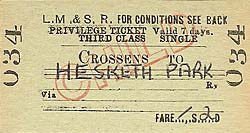 |
direction platform, at the northern end, when an electric train was already present at the southern end. This arrangement allowed passengers who arrived from Tarleton to walk a short distance along the platform to join the electric train to Southport. The railmotor was not a success and was withdrawn on 1 October 1913.
On 1January 1922 the LYR was absorbed by the London & North Western Railway but a year later that company became part of the London Midland & Scottish Railway (LMS). By November 1925 a third siding had been added in the down goods yard at its furthest point from the main line. The down yard then had a capacity of 36 wagons.
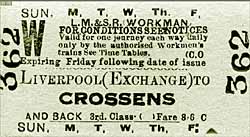 |
By the summer of 1932 Crossens had 44 weekday electric services to Southport. By this time they mostly ran as a shuttle service between Southport and Crossens. These were supplemented by 17 steam-hauled services from Preston. There were 17 trains to Preston, one to Accrington, one to Todmorden and one that was advertised as travelling ‘onward to the |
East Lancashire District’. The first departure from Crossens was for Preston at 5:59 am. The last was for Southport at 11:13pm.
At some point during the LMS era a footbridge was added at the southern end of the station. Electric lighting on iron standards was also installed in the inter-war years.
| On 1 January 1948 Crossens became part of the nationalised British Railways (London Midland Region). Throughout the 1950s the station retained its frequent electric trains along with a good service between Southport and Preston. On Bank Holidays additional electric services were run. In winter 1956/7 Crossens had 20 weekday services to Preston, one to |
4.jpg) |
Accrington and 54 services to Southport Chapel Street; 34 of the Southport services were electrics that had terminated at Crossens and then returned to Southport Chapel Street. Electric trains to and from Southport ran via Meols Cop, where they reversed. Crossen’s signage was modernised after 1956 when LMR totem signs and complementary running-in nameboards were installed.
Railway Magazine (July 1959) reported that the LMR was considering closure of a number of lines and stations by the end of that year, including the steam-operated route between Crossens and Preston. Some of the threatened closures did take place (including Hundred End station on the Preston line in 1962) but Crossens was not affected.
By 1962 the down yard had been reduced to two sidings and the carriage shed was no longer connected for rail purposes. It is not known when it ceased to be used as a carriage shed, but it was still listed as such in a track diagram of November 1925.
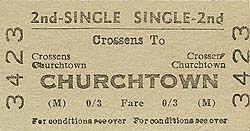 |
The Reshaping of British Railways (‘Beeching’) report of 1963 recommended the complete closure of the railway from Meols Cop through to Preston including the busy electric section, despite the fact that the services on the line were carrying over two million passengers per year. Strong local protest could not save the line and all services were withdrawn with |
effect from 7 September 1964, and Crossens station closed completely; the goods yard had recently closed, on 30 April 1964 (the down sidings were disconnected on the 6 July 1964 and had been lifted before September. The up sidings were disconnected on the 19 July 1964). On the same day the down line through the station was closed between Hesketh Park and Whitehouse West Junction Preston, and the up line was closed between Penwortham Ground frame and Hesketh Park.
On 5 January 1965 ex-LMS locomotive 44757 with 15 empty wagons passed through Crossens station on its way to Long Lane Crossing, north of Banks, in preparation for track-lifting, and work began the next day. The down line through Crossens had been lifted by 20 January 1965 and the up had gone by the end of March 1965.
The station itself survived in a derelict state for a few more years but was demolished in the late 1960s. The site was then developed first for industrial use and then much later as a residential area.
The original WLR Carriage shed survived in a derelict state until the late twentieth century. It was demolished to make way for new apartments.
Click here for a colour film showing an EMU running between Southport and Crossens in 1964.
Tickets from Michael Stewart except 1694 Alan Castle & 362 Les Fifoot, route map drawn by Alan Young, Bradshaw from Nick Catford.
See also Crossens carriage shed
Sources:
To See other stations on the Southport - Preston (West Lancashire) line click on the station name: Southport Central, Southport Windsor Road, Southport Ash Street, St. Lukes, Hesketh Park, Churchtown, Banks, Hundred End, Hesketh Bank & Tarleton, River Douglas, Hoole, Longton Bridge,
New Longton & Hutton, Penwortham (Cop Lane) & Preston West Lancashire
See also Tarleton Branch
Boat Yard Crossing Halt & Tarleton
|

old5.jpg)

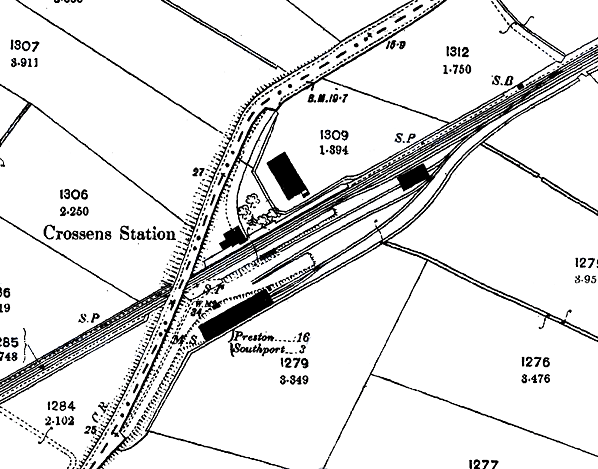
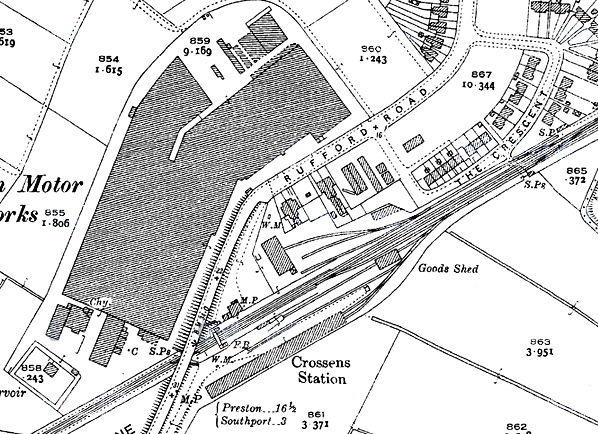
old8.jpg)
old6.jpg)
old10.jpg)
old11.jpg)
old1.jpg)
old12.jpg)
old3.jpg)
4.jpg)
1.jpg)
11.jpg)
8.jpg)
 Home
Page
Home
Page







.gif)
4.jpg)

